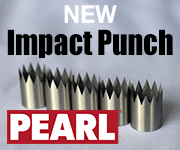Featured Stories
-
Elevating Pouch Manufacturing with Pearl Technologies' Cutting-Edge Solutions
For manufacturers seeking efficiency, precision, and safety in pouch production, Pearl delivers unmatched innovation across three standout... -
Faster Product Composition Analysis Equals Better Quality Assurance
Near Instant Testing and Reduced Costs to be Found -
Methods to Precisely Measure Tension and Web Control
How to Control Automatically Within Set Parameters
News | New Products
-
PACKZ 11 Launches with Industry-First RIP Integration
Plus extended CF2 format and automated support for 2-D Barcodes as Required by the Sunrise 2027 Initiative
-
Double E Group Acquires CAC, Further Enhancing its Strength in the Global Converting Industry
Double E Group, a global leader in converting components and web handling technology, has announced its acquisition of Converter Accessory Corporation (CAC)
-
Nobelus Launches Entry-Level Komfi® Thermal Laminator
FINISHING SOLUTIONS SUPPLIER OFFERS NEW JUNIOR 52 LAMINATING SYSTEM
-
Double E Group Mourns the Loss of Founder and Converting Industry Pioneer, Richard Edward Flagg
Double E Group announces with profound sadness the passing of its founder, Richard Edward “Ed” Flagg, on June 23, 2025. He was 85.
-
Convertech Brand to Fully Transition to Double E Group Same Team, Same Excellence, Unified Name
Double E Group has announced that Convertech, one of its subsidiaries and a trusted provider of core chucks and shaft solutions for the converting industry, will now operate solely under the Double E Group brand.
-
Pulse is Making Print Simple at Labelexpo Europe 2025
Narrow web ink specialist Pulse is Making Print Simple at Labelexpo Europe 2025, as it challenges flexo printers to rethink how they work and shows solutions that turn production bottlenecks into revenue generators.
-
ROTOCON to debut at Labelexpo Europe with three machine demonstrations
ROTOCON will make its Labelexpo Europe debut, exhibiting together with HS Machinery on stand 4D21.
Expert Advice
History, Shellfish, Royalty, and the Color Purple
- Published: July 01, 2002, By Dr. Richard M. Podhajny, Ph.D. Contributing Editor
Understanding color is one of the keys to success in the printing industry. It also can be very interesting history.
A dictionary defines purple as “any of a group of colors with a hue between that of violet and red” and as a “symbol of royalty or high office.” Historically, the color purple has been associated with royalty and power, but the secret of its power lies in the glands of tiny shellfish creatures.
The earliest archaeological evidence for the origins of purple dyes points to the Minoan civilization in Crete, about 1900 B.C. The ancient land of Canaan (its corresponding Greek name was Phoenicia, which means “land of the purple”) was the center of the ancient purple dye industry.
“Tyrian Purple,” the purple dye of the ancients mentioned in texts dating back to about 1600 B.C., was produced from the mucus of the hypobranchial gland of various species of marine mollusks, notably Murex. It took some 12,000 shellfish to extract 1.5 grams of the pure dye. Legend credits its discovery to Herakles, or rather to his dog, whose mouth was stained purple from chewing on snails along the Levantine coast. King Phoenix received a purple-dyed robe from Herakles and decreed the rulers of Phoenicia should wear this color as a royal symbol.
Although originating in Tyre (hence the name), man's first dye chemical industry spread throughout the world.
Rome, Egypt, and Persia all used purple as the imperial standard. Purple dyes were rare and expensive; only the rich had access to them. The purple colorants used came from different sources, most from the dye extraction from fish or insects.
The imperial purple of Rome was based on mollusk from which purpura comes. Emperor Aurelian refused to let his wife buy a purpura-dyed silk garment, as it cost its weight in gold!
Insect and snail animal-based colors were mentioned in the Bible for use in textile furnishings of the Tabernacle and for the sacred vestments for the High Priest Aaron, and they also were used in King Solomon's and King Herod's temples in Jerusalem.
With the decline of the Roman Empire, the use of “Tyrian Purple” also declined, and large-scale production ceased with the fall of Constantinople in 1453 A.D. It was replaced by cheaper dyes such as lichen purple and madder.
Pope Paul II in 1464 introduced the so-called “Cardinal's Purple,” which was really scarlet extracted from the Kermes insect. This became the first luxury dye of the Middle Ages.
Dyes were exported extensively from Central and South America during Spain's exploration of North and South America. Among these were Cochineal from Mexico and Peru.
The chemical birth of the synthetic dye industry can be traced to the discovery of an aniline-based purple dye, mauveine, by William H. Perkin in 1856, who accomplished this while searching for a cure for malaria. Perkin was an English chemist who changed the world of his time by making this purple color available to the masses. It became quite fashionable to wear clothing dyed with “mauve,” and Mr. Perkin became a very wealthy man.
In 1909 Paul Friedlander determined the major chemical composition of Murex dye as 6,6'-dibromoindigo.
Today, genuine “Tyrian Purple” remains the domain of the rich and famous. However, synthetic dyes and pigments that meet various purple color requirements have removed the mystique of the color purple.
Editor's Note: Mars Inc. will add purple to the mix of colors for its M&M's candies next month.
Dr. Richard M. Podhajny has been in the packaging and printing industry for more than 30 years. Contact him at 215/616-6314; rpodhajny@colorcon.com.






















